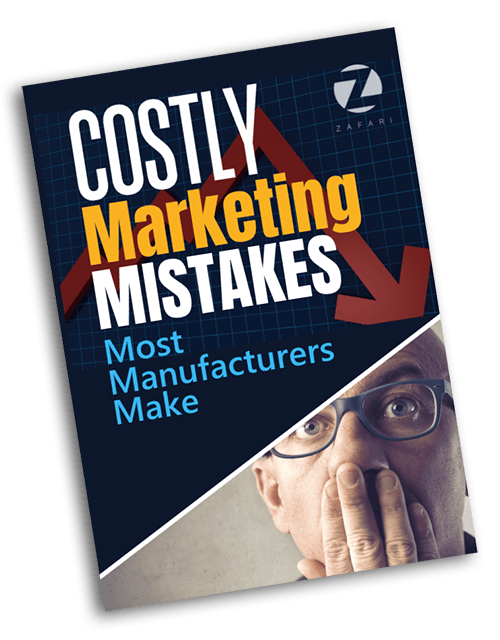If you have read the best seller, “The 1-Page Marketing Plan: Get New Customers, Make More Money, And Stand Out From The Crowd” [affectionately known as “1-Page Marketing Plan” by insiders] by Allan Dib, you know it is one of the best guides on marketing strategy out there. Allan recently published a follow-up book focused on how to implement the 1-Page Marketing Plan called “Lean Marketing—More Leads. More Profit. Less Marketing”.
In marketing, it’s all too easy to get caught up in ‘shiny object syndrome’ and never actually get around to executing the essential strategies that will move the needle.
This could be because many industrial manufacturers, including our clients, find it difficult to implement the 1-Page Marketing Plan into their marketing. There is no doubt that the concept is brilliant. However, the complexities of the manufacturing industry can make it seem impossible to apply such an elegant concept.
However, fear not!
In this guide, we will break down the process and offer actionable insights to help you develop and implement an effective 1-page Marketing Plan strategy tailored specifically to your business.
By putting the principles of the 1-Page Marketing Plan into action via the Lean Marketing execution plan, your company can reap the benefits of these wildly popular books.
Let’s get started!
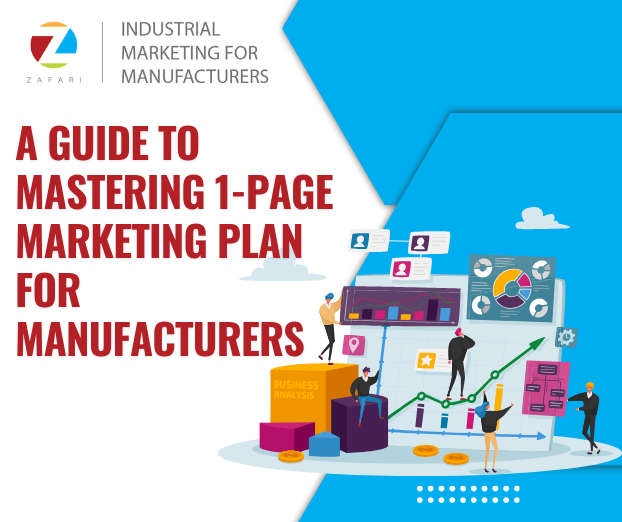
What is the 1 Page Marketing Plan?
In today’s competitive market, manufacturers face a myriad of challenges in reaching and engaging their target audience effectively. Amidst these challenges, Allan Dib’s 1-Page Marketing Plan offers a concise and actionable framework that can revolutionize the way manufacturers approach their marketing strategies. By adopting this method, manufacturers can streamline their efforts, optimize resources, and achieve sustainable growth.
As the name suggests, the 1-Page Marketing Plan is a simple marketing framework that helps crystalize your thinking by putting your entire marketing plan onto a single page, called a ‘canvas’. It is divided into nine areas, each focusing on crucial elements of marketing strategy.
Each area on the 1-Page Marketing Plan Canvas is categorized by the different stages or phases of the customer journey: Before, During, and After. Each phase marks the process of turning prospects into a loyal customer.
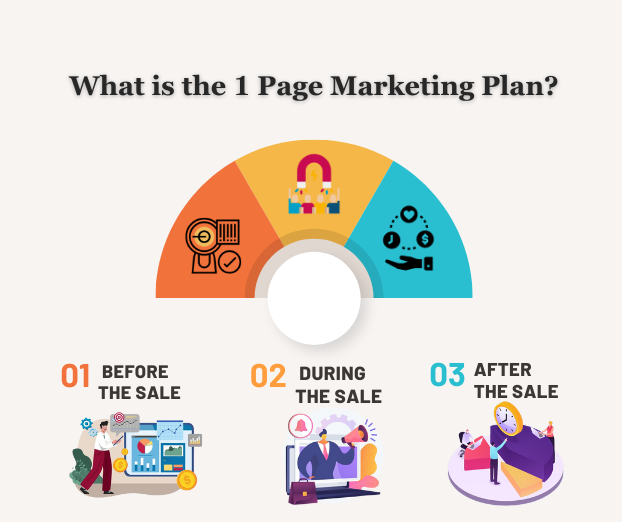
The squares on the canvas are arranged within customer journey phases as follows:
The Before Phase:
- Target Market Identification: Define your ideal customer profile and niche.
- Crafting Your Message: Develop a clear Unique Selling Proposition (USP) that resonates with your target market.
- Choosing Marketing Media: Select appropriate channels and platforms based on budget, goals, and audience.
The During Phase:
- Capturing Attention: Create compelling lead magnets to attract prospects and collect their contact information.
- Nurturing Leads: Develop automated and personalized lead nurturing systems to educate and build trust.
- Converting Customers: Design smooth and persuasive sales conversion strategies addressing customer needs and concerns.
The After Phase:
- Delivering World-Class Experience: Ensure excellent product/service delivery, customer service, and support to exceed expectations.
- Increasing Lifetime Value: Implement strategies to encourage repeat purchases and higher spending from existing customers.
- Stimulating Referrals: Develop referral systems to incentivize and facilitate customers in referring others.
Refer to the image given below to understand how this plan works.
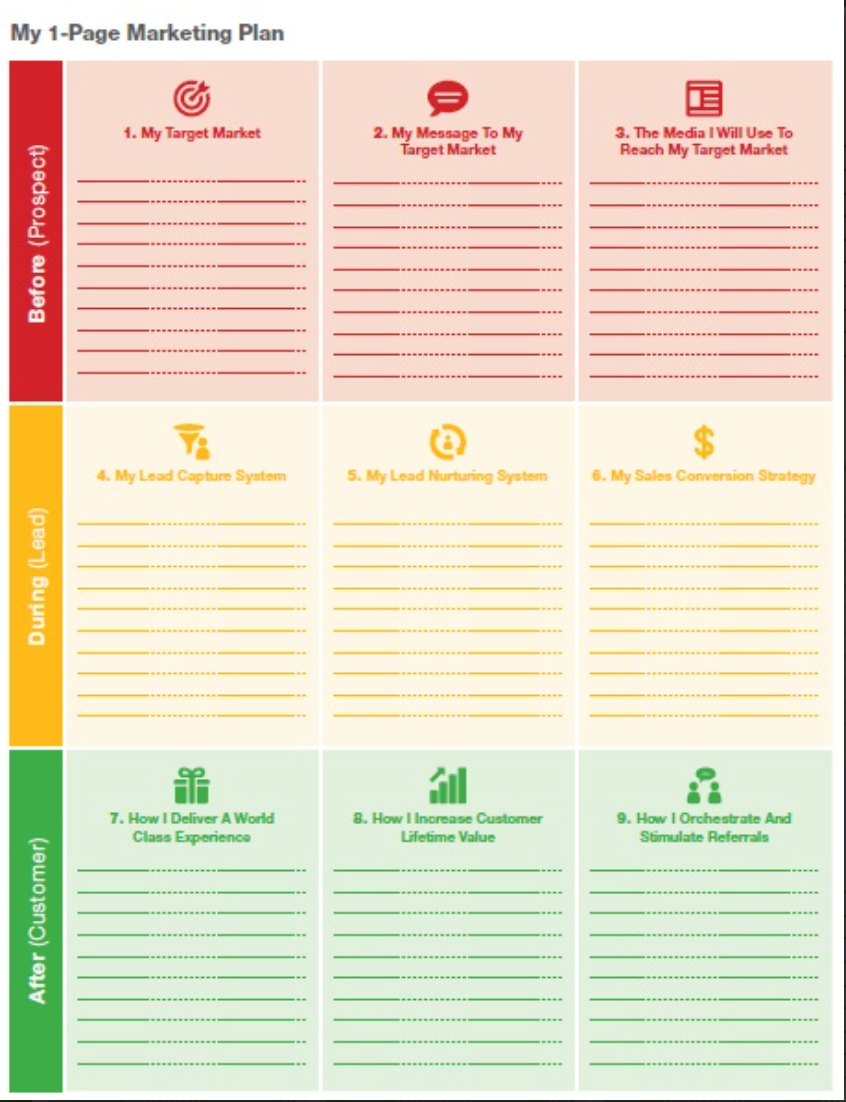
Conclusion and Next Steps
By thinking through each square and condensing it onto this canvas, manufacturers can create a clear and actionable roadmap for their marketing activities.
The next points will walk us through the benefits of a 1-Page Marketing Plan for industrial companies and how to implement it.
How is a 1-Page Marketing Plan Connected to Lean Marketing?
The “1-Page Marketing Plan” simplifies complex, overwhelming marketing strategies into a straightforward, one-page plan suitable for any industry and business stage.
The role of “Lean Marketing” is to help you with the implementation of all those strategies.
How Does a 1-Page Marketing Plan Explain Marketing?
Is marketing about advertising, promotion, publicity, PR, or sales?
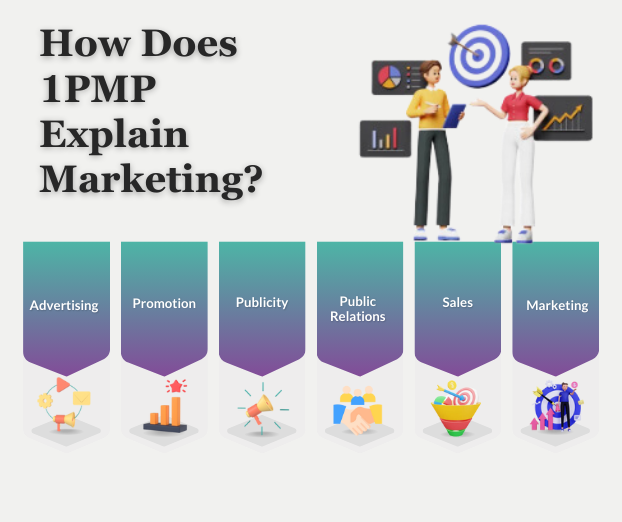
Well, marketing all of that and more. Dib explains this in 1 PMP using a clever analogy:
Advertising:
This is like putting up a sign saying the circus is here.
Promotion:
Now, if you attach that sign to an elephant and parade it through town, that’s promotion. It’s making a big show to grab people’s attention.
Publicity:
If the elephant accidentally tramples the mayor’s flowers and the newspaper writes about it, that’s publicity. It’s getting attention for free, even if it’s not exactly good news.
Public Relations:
Then, if you manage to smooth things over with the mayor and make him laugh, that’s public relations. It’s about keeping a good image for the circus.
Sales:
When you talk to people at the circus and convince them it’s worth their time and money, that’s sales. It’s sealing the deal.
Marketing:
Marketing is what orchestrated all of this! All of this only works if it’s planned out carefully. That’s where marketing comes in. It’s like being the mastermind behind the whole circus operation – from figuring out who might be interested, to making sure they have a great time, to measuring how well everything went and learning from it for next time.
Based on this analogy, we can say that…
- Advertising is the process of creating and showcasing a message to inform or convince your audience.
- Promotion is all about boosting the visibility and recognition of your message.
- Publicity means getting media exposure.
- PR helps you establish an image and reputation for your business.
- Sales helps convince and finalize deals with potential customers.
What is the Importance of the 1-Page Marketing Plan for Manufacturers?
Marketing for B2B industrial manufacturers can be quite complicated. But believe it or not, many manufacturers don’t have a marketing plan at all. Or they have a plan that is not tailored to their business or is outdated or irrelevant. Maybe they are using a plan that is meant for consumer marketing, not for B2B.
We agree with Allan Dib: a good marketing plan is one that you will actually follow. Therefore, it should be simple, easy to use, and help you make decisions every day. Nowadays, consumers have lots of options, and they see so many ads that they ignore most of them. However, they remain loyal to the brands they like and trust.
That’s why you need an industrial marketing plan that can help with such a scenario.
It should help you stand out, get the right customers, and keep them satisfied for a long time.
Above all, it should be based on what you know works, not just guessing.
The One-Page Marketing Plan fits the bill. It’s simple, practical and helps you achieve goals. However, many marketers find it challenging to implement in their industrial B2B marketing campaigns.
So let’s address this issue.
What Challenges Do Industrial Marketers Face When Implementing the 1 PMP?
Implementing a 1-Page Marketing Plan for a manufacturing company comes with its own set of challenges given below:
Complexity:
B2B manufacturers have many complicated processes to go through. On top of that, they have multiple product lines and diverse customer segments. No wonder they find it challenging to distill their marketing strategy into a single page!
Multiple Market Segments:
B2B manufacturers often cater to various market segments, each with its unique needs and preferences. Deciding whether [and how] to create separate marketing plans for each segment adds another layer of complexity.
Execution Prioritization:
While understanding the strategy is one thing, implementing it amidst routine operations can be quite another. If you don’t have a clear roadmap, you can easily lose focus and momentum.
How to Implement the 1-Page Marketing Plan for Industrial Companies with Lean Marketing
While a 1-Page Marketing Plan outlines all elements of marketing practically, it might not be easy for some industrial B2B manufacturers or marketers to apply.
However, with some planning and a deep understanding of the core of 1 PMP, you can successfully use the 1 Page Marketing Plan for industrial companies.
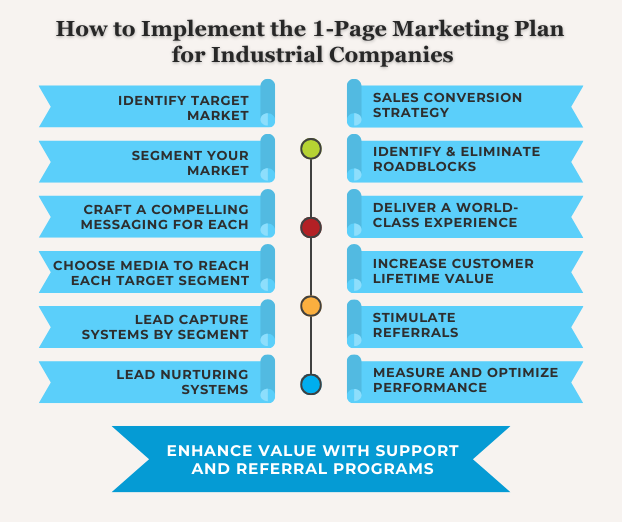
The principles (phases and canvas squares) of the 1 Page Marketing Plan boil down to the key steps given below along with examples. It will help you understand how to incorporate it into your manufacturing marketing plan.
Let’s get started:
Target Market:
Identify your ideal customer persona. Understand their demographics, psychographics, pain points, and desires. Tailor your marketing efforts to resonate deeply with this audience segment.
Message:
Craft a compelling message that speaks directly to your target market’s needs and aspirations. Communicate the unique value proposition of your product or service and how it solves their problems or fulfills their desires.
Media:
Select the most effective channels to reach your target market. Whether it is social media, email marketing, content marketing, or traditional advertising, choose platforms where your audience is most active and receptive to your message.
Lead Capture System:
Develop a systematic approach to capture leads and prospects. Use lead magnets, landing pages, and opt-in forms to entice visitors to provide their contact information in exchange for valuable content or offers.
Lead Nurturing System:
Implement a strategy to nurture leads and build relationships over time. Use email sequences, personalized content, and targeted messaging to educate, engage, and guide prospects through the buyer’s journey.
Sales Conversion:
Optimize your sales process to maximize conversions. Develop persuasive sales copy, offer compelling incentives, and provide seamless purchasing experiences to encourage prospects to take action and become customers.
World-Class Experience:
Deliver exceptional customer experiences at every touchpoint. Focus on providing value, solving problems, and exceeding expectations to create loyal customers who become brand advocates.
Customer Lifetime Value:
Focus on maximizing the lifetime value of each customer. Encourage repeat purchases, upsells, and cross-sells by offering additional products or services that complement their initial purchase and continue to add value over time.
Stimulate Referrals:
Encourage satisfied customers to refer their friends, family, and colleagues to your business. Implement referral programs, provide incentives, and deliver outstanding service to turn customers into enthusiastic brand ambassadors who actively promote your products or services to others.
Identify Your Unique Selling Proposition (USP):
Determine what sets your products or services apart from competitors. Is it superior quality, innovative technology, cost-effectiveness, or exceptional customer service? Mention your USP to tell value to your target audience.
Example:
A switchgear manufacturer might differentiate itself by offering innovative technology that promotes safety and efficiency in industrial settings. Their USP could be a patented circuit protection mechanism that minimizes downtime and reduces maintenance costs for their customers.
Segment Your Market:
The next point is to get familiar with your customer base. Understand their pain points and preferences. Based on this data, you can then segment your market based on industry, company size, geographical location, purchasing behavior, or any other relevant factors. This way, you can create compelling marketing messages tailored to each segment’s needs.
Example:
A chemical manufacturer may segment its market based on the industries it caters (pharmaceuticals, agriculture, automotive). They can customize their marketing approach to meet the unique needs of each segment.
Craft A Compelling Messaging:
The next step is to create a clear and compelling message that will resonate with your target audience. This is where StoryBrand shines like the sun! Make sure to highlight the benefits of your products or services from the customer’s perspective and address how they solve their biggest pain points. Once developed, your message should be used consistently across all touchpoints like website content, email campaigns, or sales collateral.
Example:
ABC, a lathe machine manufacturer, had no idea on how, where, and when to include their product and technical details.
With the guidance of the StoryBrand framework, they gained clarity on how to seamlessly integrate this crucial information.
They created web pages for detailed product descriptions, offering customers insights into the basics of their offerings. Additionally, ABC strategically places links to PDF brochures and catalogs on the same pages, catering to those seeking tangible information.
To further engage their audience, they leverage video demonstrations that showcase their machines in action, highlighting their user-friendly interfaces and ergonomic designs. For customers seeking personalized guidance, their customer support team is readily available for consultations.
By using their website, videos, and support team, ABC makes sure everyone understands their products and can make the right choice.
Leverage Digital Marketing Channels:
Use platforms such as LinkedIn, Twitter, and industry-specific forums to establish thought leadership and connect with potential customers. Invest in industrial internet marketing that covers search engine optimization (SEO), content marketing, email marketing, and pay-per-click (PPC) advertising to expand your reach and drive traffic to your website.
Example:
An industrial equipment manufacturer utilizes LinkedIn to share case studies, whitepapers, and industry insights. By engaging with relevant groups and participating in discussions, they establish credibility and attract potential customers seeking solutions in their niche.
Measure and Optimize Performance:
See how your marketing campaign is going by tracking metrics like lead generation, website traffic, conversion rates, and engagement. Using this data will help you learn about your strengths, loopholes, and opportunities.
Example:
A robotics manufacturer may track website traffic, leads generated from downloadable resources, and conversion rates from email campaigns. This way, they can find out which marketing channels or tactics are working.
Enhance Value with Support and Referral Programs:
Things are not over when your products are sold. You need to keep your customers coming back to you by offering them outstanding customer support. Offer incentives, discounts, or rewards to your customers for referring your products to others.
Example:
John, the operations manager at a construction firm, has been using ABC’s machinery for several years. He has always been impressed with the reliability and performance of their equipment. He recently recommended ABC to a colleague at another construction company who was looking to upgrade their machinery. Thanks to John’s referral, the new client purchases a set of heavy-duty excavators from ABC.
As a token of appreciation for John’s referral, ABC offers him a 10% discount on his next equipment purchase, along with a complimentary maintenance service for his existing machinery. The new client also receives a 5% discount on their initial purchase and access to a specialized training session for their operators.
This win-win scenario not only strengthens the relationship between ABC and its existing customers but also attracts new clients through positive recommendations and valuable incentives.
Tap into Our Expertise in 1-Page Marketing Plan and Lean Marketing Strategies
Leveraging a 1-Page Marketing Plan alongside Lean Marketing strategies can be a game-changer for manufacturers and industrial companies. It drives productivity and broadens your customer base when executed effectively.
If it still feels complicated to put together the 1-Page Marketing Plan and Lean Marketing or you don’t have time and resources for that, we’ve got you covered.
At Zafari, our certified team of industrial marketing experts knows all the ins and outs of creating and implementing both frameworks. We create tailored marketing plans for industrial companies just like you every day.
So why stress over it alone?
Let’s collaborate to create your 1-Page Marketing Plan and implement Lean Marketing practices, propelling your B2B manufacturing firm to new heights. Connect with us today to embark on this transformative journey!

